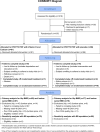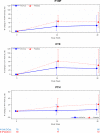Vitamin D and Calcium Attenuate Bone Loss With Antiretroviral Therapy Initiation: A Randomized Trial
- PMID: 26075752
- PMCID: PMC4608553
- DOI: 10.7326/M14-1409
Vitamin D and Calcium Attenuate Bone Loss With Antiretroviral Therapy Initiation: A Randomized Trial
Abstract
Background: Antiretroviral therapy initiation for HIV-1 infection is associated with 2% to 6% loss of bone mineral density (BMD).
Objective: To evaluate the effect of vitamin D3 plus calcium supplementation on bone loss associated with antiretroviral therapy initiation.
Design: 48-week prospective, randomized, double-blind, placebo-controlled study. (ClinicalTrials.gov: NCT01403051).
Setting: 39 AIDS Clinical Trials Group units.
Patients: Adults with antiretroviral therapy-naive HIV.
Measurements: BMD by dual-energy x-ray absorptiometry, 25-hydroxyvitamin D levels, and other laboratory assessments.
Results: 165 eligible patients were randomly assigned (79 received vitamin D3 plus calcium and 86 received placebo). The study groups were well-balanced at baseline: 90% were men, 33% were non-Hispanic black, and the median CD4 count was 0.341 × 109 cells/L. At 48 weeks, the percentage of decline in total hip BMD was smaller in the vitamin D3 plus calcium group than in the placebo group: Medians were -1.36% (interquartile range [IQR], -3.43% to 0.50%) and -3.22% (IQR, -5.56% to -0.88%), respectively (P = 0.004). Similar results were seen at the lumbar spine. At 48 weeks, 90% of patients achieved HIV-1 RNA levels less than 50 copies/mL. Levels of 25-hydroxyvitamin D3 increased with vitamin D3 plus calcium but not with placebo: Median change was 61.2 nmol/L (IQR, 36.4 to 94.3) versus 1.7 nmol/L (IQR, -13.2 to 10.7) (P < 0.001). Overall, 103 patients (62%) reported 1 or more adverse event, with similar distribution between groups; no cases of hypercalcemia and 1 case of nephrolithiasis were reported in the placebo group.
Limitation: No international sites were included, and follow-up was only 48 weeks.
Conclusion: Vitamin D3 plus calcium supplementation mitigates the BMD loss seen with initiation of efavirenz/emtricitabine/tenofovir disoproxil fumarate.
Figures




References
-
- Weber R, Ruppik M, Rickenbach M, et al. Decreasing mortality and changing patterns of causes of death in the Swiss HIV Cohort Study. HIV Med. 2013;14:195–207. - PubMed
-
- Young B, Dao CN, Buchacz K, et al. HIV Outpatient Study (HOPS) Investigators Increased rates of bone fracture among HIV-infected persons in the HIV Outpatient Study (HOPS) compared with the US general population, 2000-2006. Clin Infect Dis. 2011 Apr 15;52(8):1061–8. - PubMed
-
- Bedimo R, Maalouf NM, Zhang S, et al. Osteoporotic fracture risk associated with cumulative exposure to tenofovir and other antiretroviral agents. AIDS. 2012 Apr 24;26(7):825–31. - PubMed
Publication types
MeSH terms
Substances
Associated data
Grants and funding
LinkOut - more resources
Full Text Sources
Medical
Research Materials
